In the fast-paced world of email marketing, timing is a crucial element that can make or break the success of your campaigns. With inboxes becoming increasingly crowded, it’s essential to find the optimal moment to send your messages and capture your audience’s attention. When it comes to Thursdays, many marketers find themselves pondering the age-old question: what is the best time to hit the “send” button for maximum impact?
This comprehensive guide explores the best times to send emails on Thursdays, integrating hidden gem strategies that may not be widely recognized but can significantly enhance your email marketing effectiveness. Additionally, we will delve into how Prism Reach, an innovative AI-powered SaaS solution, can complement these strategies by enhancing email scheduling, personalization, and analytics.
At a Glance
- Understanding the importance of send times in email marketing.
- Integrating hidden gem strategies to optimize Thursday email sends.
- Leveraging Prism Reach for personalized and data-driven email campaigns.
- Best practices for determining the optimal send times.
- Utilizing analytics and automation to continuously improve email performance. “On the highway to user/product love, lifecycle emails are road signs providing timely guidance, not annoying billboards.” — Samuel Hulick
Key Facts About the Best Time to Send Email on Thursday
- The optimal send time can significantly boost open rates and engagement.
- Different audience segments may respond better to different send times.
- Time zone considerations are crucial for global audiences.
- A/B testing and analytics are essential for determining the best send times.
- Advanced scheduling tools can automate and optimize send times based on data.
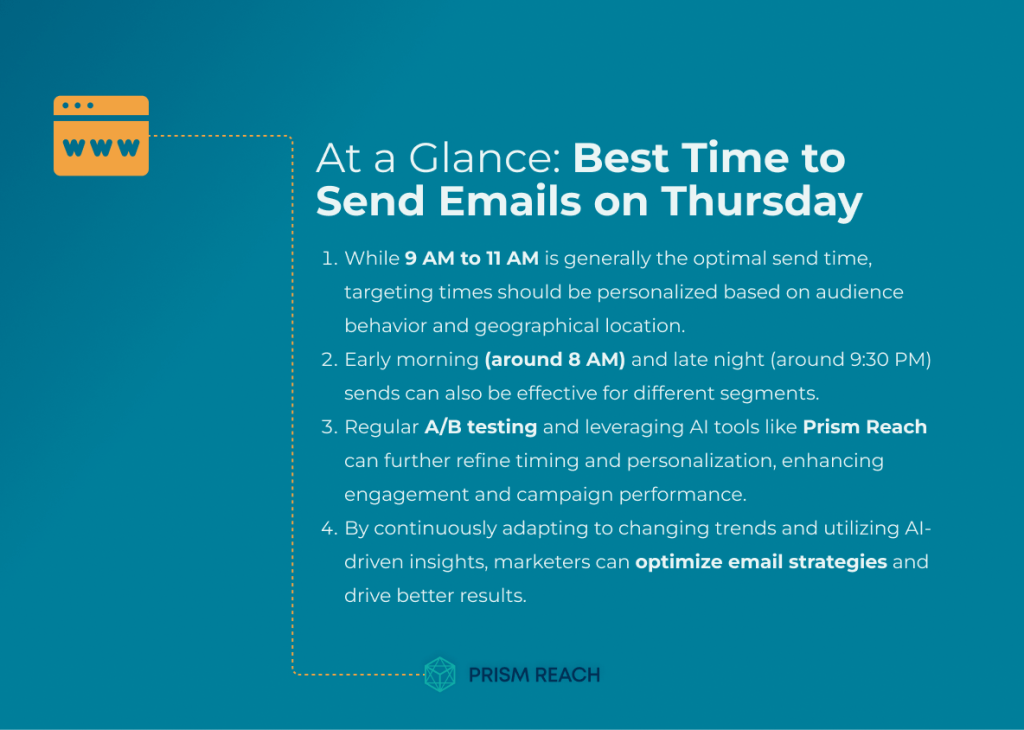
Hidden Gem Strategies for Determining the Best Time to Send Emails on Thursday
While the fundamental principles of email marketing are widely recognized, several lesser-known strategies can significantly enhance the effectiveness of your Thursday email campaigns. Here are five “hidden gem” strategies that can transform your email marketing efforts:
1. Utilize Early Afternoon Follow-Ups
Consider sending a follow-up email around 1 PM to 2 PM. This time slot captures recipients during their lunch break or right after, when they are likely to check their inboxes again.
- Potential Effectiveness: High
- Level of Obscurity: Moderate
- Ease of Implementation: Easy
- Uniqueness: Moderate
By leveraging Prism Reach’s advanced scheduling features, you can automate these follow-up sends based on subscriber behavior, ensuring timely and relevant engagement.
2. Consider Time Zones for Global Audiences
If your audience spans multiple time zones, segment your email list and send at times tailored to each zone. This ensures that your emails reach recipients during their peak engagement times.
- Potential Effectiveness: High
- Level of Obscurity: Moderate
- Ease of Implementation: Moderate
- Uniqueness: High
Prism Reach simplifies this process by automatically segmenting your audience based on their geographical data and optimizing send times accordingly, maximizing open rates across different regions.
3. Use A/B Testing for Timing
Conduct A/B tests by sending the same email at different times on Thursday (e.g., 10 AM vs. 2 PM) to determine which timing yields better engagement rates for your specific audience.
- Potential Effectiveness: High
- Level of Obscurity: Low
- Ease of Implementation: Moderate
- Uniqueness: Moderate
Prism Reach’s A/B testing tools enable you to easily set up and analyze different send times, providing actionable insights to refine your email scheduling strategies.
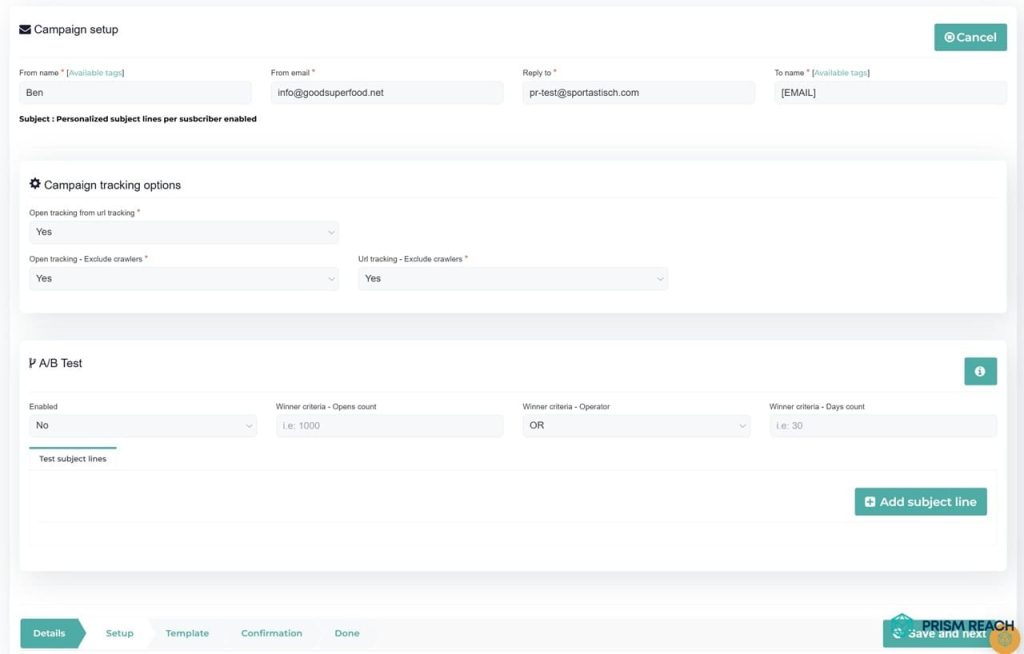
4. Leverage Analytics for Insights
Utilize analytics tools to track engagement metrics from previous Thursday campaigns. Analyzing this data can help identify trends specific to your audience’s behavior.
- Potential Effectiveness: High
- Level of Obscurity: Low
- Ease of Implementation: Moderate
- Uniqueness: Low
Prism Reach provides comprehensive analytics that allow you to monitor open rates, click-through rates, and other key metrics, helping you make data-driven decisions about the best send times.
5. Utilize Advanced Scheduling Tools
Leverage email marketing platforms with advanced scheduling features that allow you to optimize send times based on recipient behavior patterns automatically.
- Potential Effectiveness: High
- Level of Obscurity: Low
- Ease of Implementation: Easy
- Uniqueness: Low
Prism Reach’s scheduling tools use AI to predict the best times to send emails to each subscriber, ensuring your messages are delivered when they are most likely to be read.
Upgrade Your Email Marketing with AI Personalization!
Comparison: Best Time to Send Emails on Thursday
1. Early Morning Potential
- Advantages:
- Captures B2C audiences as they start their day, leading to higher engagement.
- Enhances visibility due to fewer competing emails in the inbox.
- Boosts the chance of content interaction, setting a positive tone for the day.
- Disadvantages:
- May miss those who wake up later.
- Often less effective for B2B audiences, who might check email later in the morning.
2. Avoiding the Midday Lull
- Advantages:
- Bypasses the peak of email overload, helping your message stand out.
- Generally results in better engagement after lunch when recipients are more attentive.
- Helps avoid the distraction often experienced during lunch hours.
- Disadvantages:
- Could miss active users who check email during lunch breaks.
- There’s a potential delay in response if the timing isn’t perfectly aligned with the audience’s habits.
3. Late Night Opportunities
- Advantages:
- Targets night-time email checkers who browse during leisure hours.
- Low competition in the inbox can lead to higher engagement from “night owls.”
- Often beneficial for more personal or relaxed content.
- Disadvantages:
- May miss daytime professionals who aren’t active after hours.
- Early sleepers might overlook emails sent late at night.
4. Industry-Specific Considerations
- Advantages:
- Tailors email timing to match the work habits of the target industry.
- Enhances relevance by optimizing communication for professional (B2B) or leisure (B2C) settings.
- Can drive higher engagement when aligned with industry-specific behaviors.
- Disadvantages:
- Requires in-depth audience insights to implement effectively.
- Flexibility can be limited if the industry has rigid communication patterns.
5. Geographical Differences
- Advantages:
- Allows targeting based on optimal local times, boosting global reach.
- Personalizes campaigns by adapting to cultural email habits and regional preferences.
- Can improve international engagement by aligning with specific time zones.
- Disadvantages:
- Scheduling becomes more complex due to time zone differences.
- There’s potential for confusion or misalignment if not managed carefully.
6. Personalization and Segmentation Strategies
- Advantages:
- Increases email relevance by delivering tailored content to specific segments.
- Boosts open and click-through rates by catering to individual interests.
- Enhances overall user satisfaction through personalized interactions.
- Disadvantages:
- Requires comprehensive data collection and detailed segmentation.
- The setup process can be time-consuming and complex to manage.
7. A/B Testing and Experimentation
- Advantages:
- Identifies the most effective timing and content strategies through data-driven decisions.
- Enhances overall campaign success by refining approaches based on audience responses.
- Allows for continuous improvement by adapting to changing preferences.
- Disadvantages:
- Demands ongoing management and monitoring.
- Extended timelines may be necessary to gather sufficient data for meaningful insights.
8. Leveraging Email Marketing Automation
- Advantages:
- Automates the sending process and schedules emails based on user activity.
- Reduces manual workload while ensuring timely delivery.
- Utilizes advanced targeting algorithms for more effective campaigns.
- Disadvantages:
- Requires an initial setup investment and technical resources.
- There’s a risk of over-reliance on technology if not balanced with strategic oversight.
9. Adapting to Changing Trends
- Advantages:
- Keeps your strategies ahead of market shifts, ensuring continued relevance.
- Allows for flexible adjustments in response to evolving consumer behavior and new data.
- Leverages the latest technologies and insights to refine email marketing approaches.
- Disadvantages:
- Demands constant vigilance and monitoring of trends.
- Frequent changes can lead to disruptions or inconsistencies if not managed carefully.
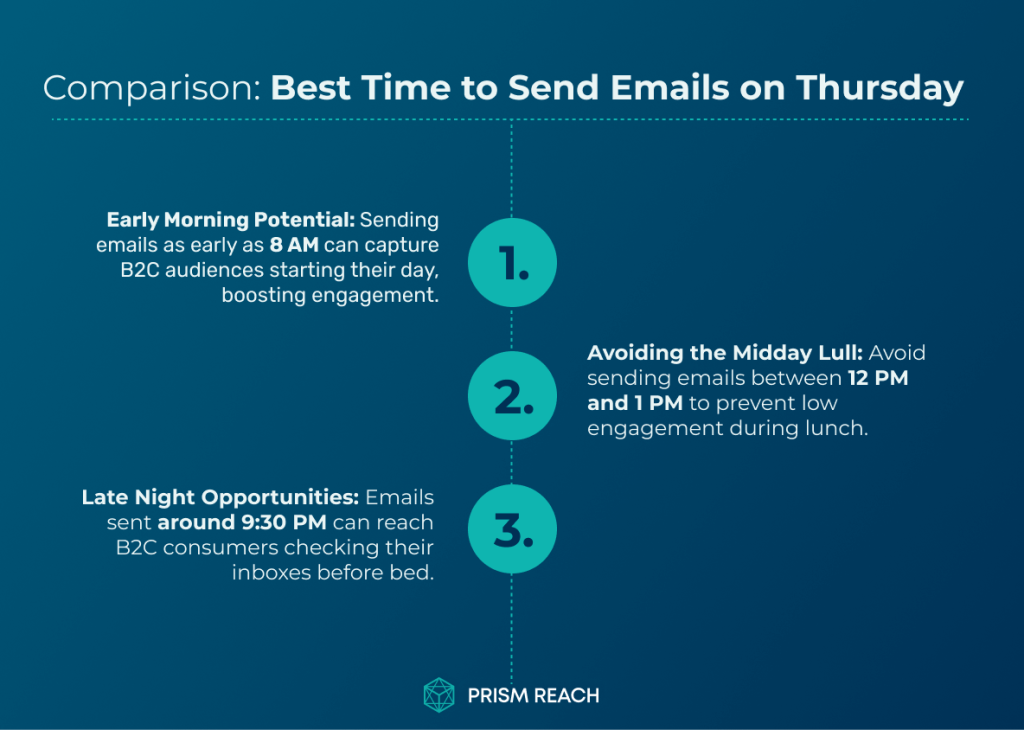
Best Practices for Determining the Optimal Send Times
Determining the best time to send emails on Thursday involves a combination of understanding your audience, leveraging data, and utilizing advanced tools. Here are some best practices to follow:
1. Analyze Your Audience
- Understand your audience’s daily routines and email-checking habits.
- Consider factors such as job roles, industries, and personal preferences.
- Use surveys or polls to gather direct feedback on preferred send times.
Prism Reach can assist in analyzing subscriber data to gain deeper insights into when your audience is most active and receptive to emails.
2. Segment Your Email List
- Segment your list based on demographics, behavior, and preferences.
- Tailor send times for each segment to maximize engagement.
- Use personalization to enhance relevance and connection with each group.
With Prism Reach’s segmentation capabilities, you can effortlessly categorize your audience and optimize send times for each segment, ensuring higher open and click-through rates.
3. Continuously Test and Refine
- Implement A/B testing to experiment with different send times.
- Analyze the results to determine what works best for your audience.
- Adapt your strategy based on ongoing testing and new insights.
Prism Reach’s A/B testing features make it easy to set up experiments and track performance, allowing you to continuously refine your email scheduling strategy for optimal results.
Enhancing Your Email Marketing with Prism Reach
While mastering the timing of your email sends is essential, leveraging advanced tools like Prism Reach can take your email marketing efforts to the next level. Prism Reach is an innovative AI-powered SaaS solution designed to enhance the effectiveness of email marketing campaigns through deep personalization, advanced analytics, and automated scheduling.
Key Benefits of Prism Reach
- Enhanced Personalization: Prism Reach uses sophisticated AI algorithms to customize every aspect of your email campaigns based on subscriber behavior and preferences, resulting in more engaging and relevant communications.
- Advanced Analytics: Gain deep insights into your email performance with comprehensive analytics, helping you understand what works and where improvements are needed.
- Automated Scheduling: Optimize send times automatically based on predictive analytics, ensuring your emails are delivered when subscribers are most likely to engage.
Prism Reach’s Advanced Features
Prism Reach offers a suite of features designed to streamline and enhance your email marketing efforts:
- AI-Powered Personalization: Clusters content into relevant categories and creates detailed user avatars for highly personalized email content.
- Seamless Setup and Integration: Quick integration within minutes with one-click uploads for existing subscriber lists.
- Dynamic Content Selection: AI determines the most relevant content for each recipient, ensuring your emails are tailored and engaging.
- Automated Proofreading: Identifies and corrects spelling, grammar, and punctuation errors to maintain professionalism.
- Tone Analysis: Assesses the tone of your emails and provides suggestions to ensure your message is clear and respectful.
- Comprehensive Analytics: Tracks email performance metrics, offering insights into open rates, click-through rates, and overall engagement.
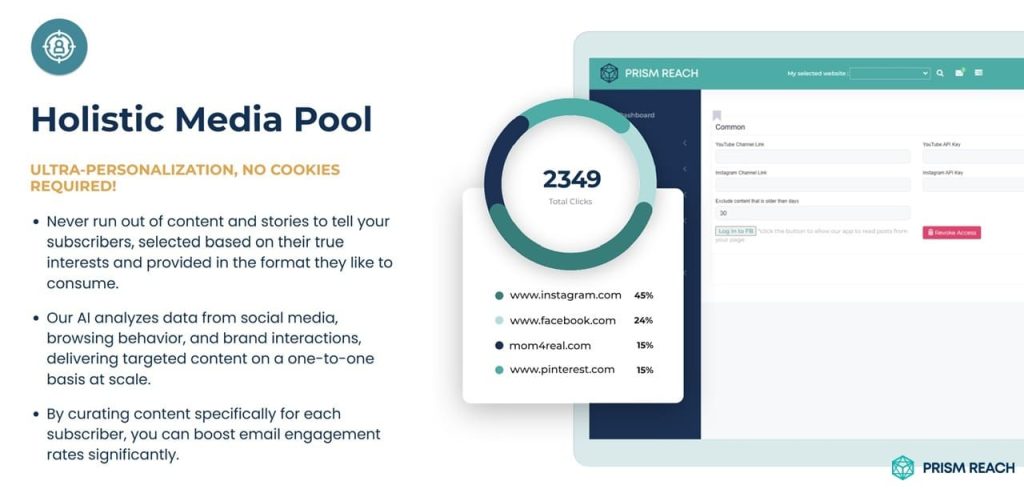
Streamlined User Journey with Prism Reach
The typical user journey with Prism Reach involves a streamlined process where you set up your account, import your contact list, and begin crafting personalized email campaigns with the help of AI-driven tools. Subscribers receive tailored messages that resonate with their preferences and behaviors, enhancing their experience and increasing the likelihood of positive interactions.
Compliance and Data Privacy
Prism Reach places a strong emphasis on GDPR compliance and hosts data within secure, European servers, adhering to the highest standards of data protection. This focus on privacy is crucial for building trust with your recipients and ensuring that your email communications comply with international regulations.
Future Prospects
Looking ahead, Prism Reach aims to expand its capabilities by integrating more advanced AI features and expanding into new sectors such as eCommerce. The company is committed to continuous improvement, ensuring that its solutions remain at the forefront of email marketing technology and innovation.

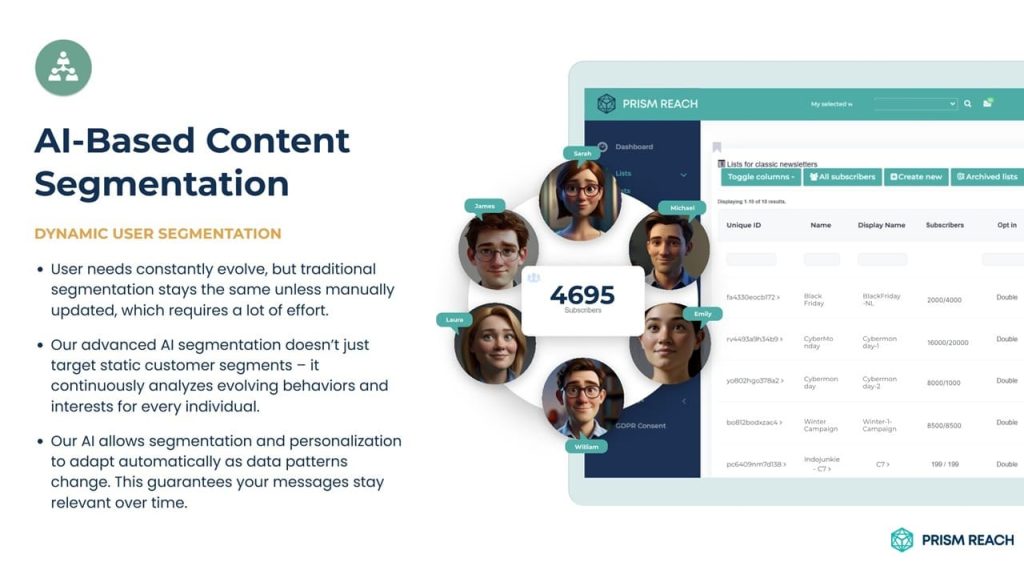
Maximizing Email Marketing Effectiveness with Prism Reach
Email marketing remains one of the most effective channels for nurturing leads, driving conversions, and fostering long-lasting customer relationships. Prism Reach can help you craft compelling email campaigns that resonate with your subscribers, ensuring higher engagement and click-through rates.
Prism Reach Integration Benefits
Integrating Prism Reach into your email marketing strategy offers several benefits:
- Personalized Engagement: Tailor email content to individual subscriber preferences, enhancing relevance and interaction.
- Automated Optimization: Utilize AI to automatically adjust send times and content for optimal performance across devices.
- Data-Driven Insights: Leverage comprehensive analytics to understand banner effectiveness and refine your strategies accordingly.
By harnessing these benefits, Prism Reach ensures that your email campaigns are not only visually appealing but also strategically effective in driving engagement and conversions.
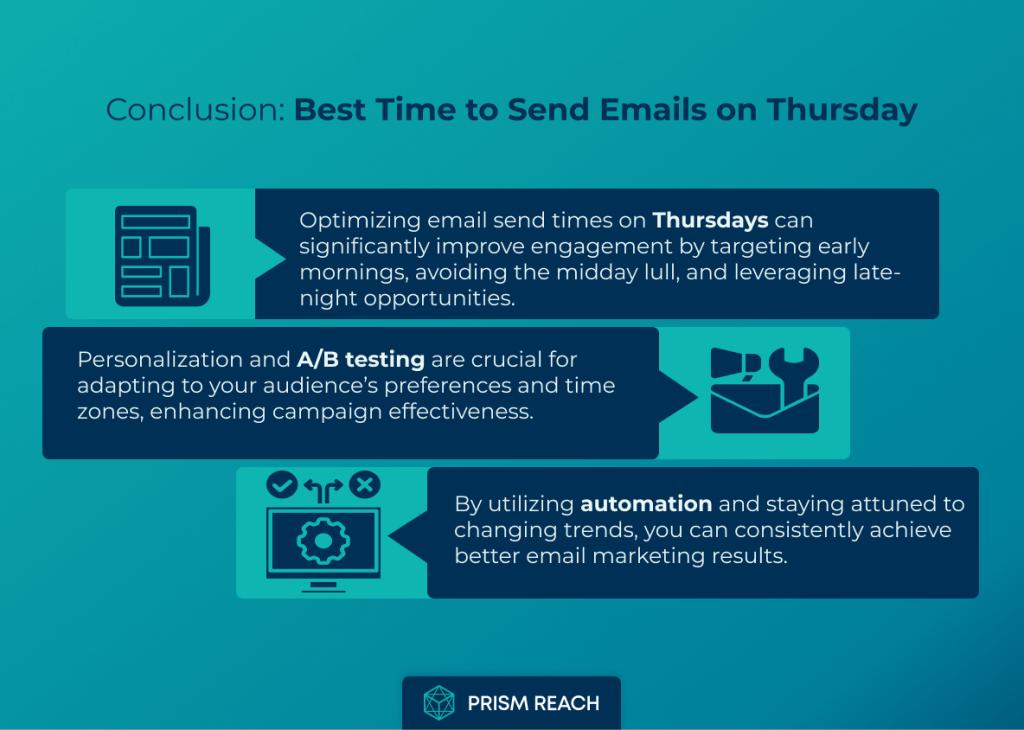
Conclusion
Determining the best time to send emails on Thursday involves understanding your audience, leveraging data, and utilizing advanced tools. By integrating hidden gem strategies such as early afternoon follow-ups, considering time zones, conducting A/B testing, leveraging analytics, and utilizing advanced scheduling tools, you can significantly enhance the effectiveness of your email campaigns.
Furthermore, leveraging tools like Prism Reach can take your email marketing efforts to new heights. With its AI-driven personalization, advanced analytics, and automated scheduling features, Prism Reach simplifies the process of delivering the right message to the right audience at the right time. This not only boosts engagement and open rates but also drives higher conversions and revenue.
In a world where countless emails compete for attention, optimizing your send times on Thursdays can be the differentiating factor that sets you apart. By mastering the optimal send times and incorporating the right strategies, you can create email campaigns that not only inform but also captivate and inspire action.
So, whether you’re a seasoned email marketer or just starting out, take these insights to heart and begin your journey towards Thursday email success. With the right tools, mindset, and a commitment to delivering value to your subscribers, there’s no limit to what you can achieve.
Sources
- Metranomic – Master Email Scheduling: Essential Tools & Tips for Perfect Timing
- AudiencePoint – Best Time to Send an Email on Thursday
- OptinMonster – The Best Time to Send Emails: Here’s What Studies Show
- WordStream – Best Time to Send Email Campaigns
- Smaily – When is the Best Time to Send an Email? Understanding the 11 Crucial Factors